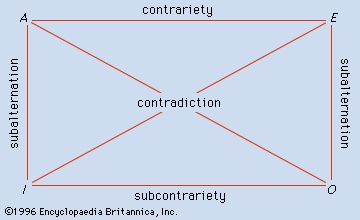opposition, square of
logic
in traditional logic, a diagram exhibiting four forms of a categorical proposition (q.v.), or statement, with the same subject and predicate, together with their pairwise relationships:

in which A, E, I, and O are of the forms “Every S is P,” “No S is P,” “Some S is P,” and “Some S is not P.” As shown on the square, “Every swan is white” is the contrary of “No swan is white” and the contradictory of “Some swans are not white.” Conclusions drawn from one of these forms to another (as in subalternation) are said to be obtained by immediate inference.
- Holy Family, Feast of the
- Holyfield, Evander
- Holy Ghost Father
- Holyhead
- Holy Innocents, Feast of the
- Holy Island
- Holy Lance
- Holy League
- Holyoake, Sir Keith Jacka
- Holy of Holies
- Holyoke
- Holyoke, Edward
- holy order
- Holy Roman emperors
- Holy Roman Empire
- Holy Saturday
- Holy Sepulchre
- Holy Spirit
- Holy Trinity, Feast of the
- holy war
- holy water
- Holy Week
- Holywell
- homage and fealty
- Homburg